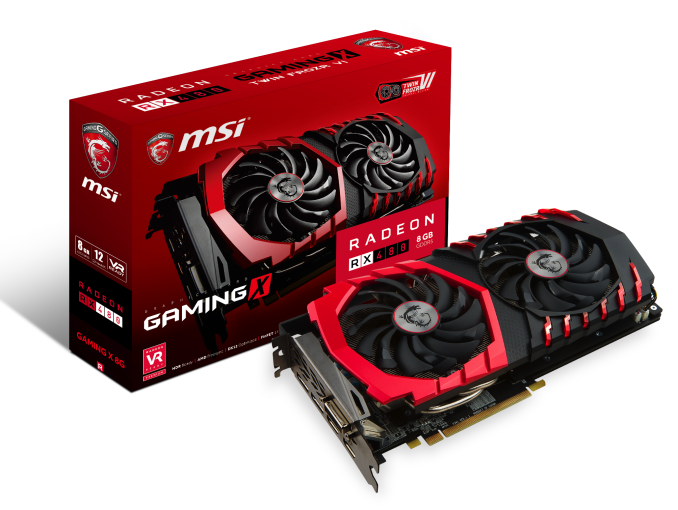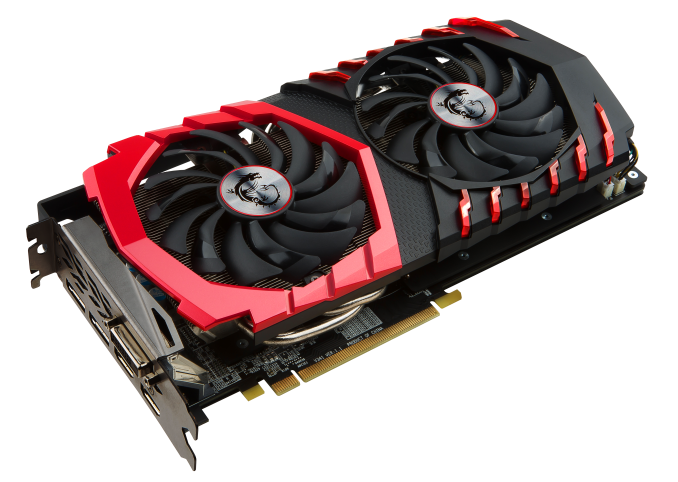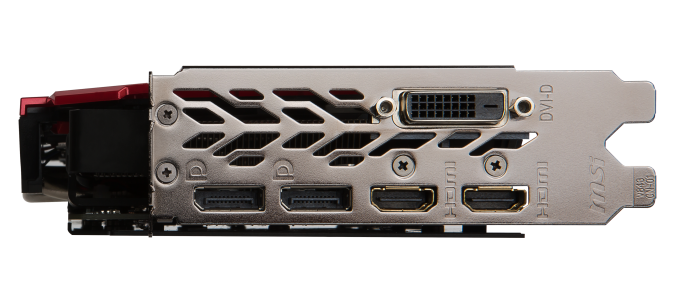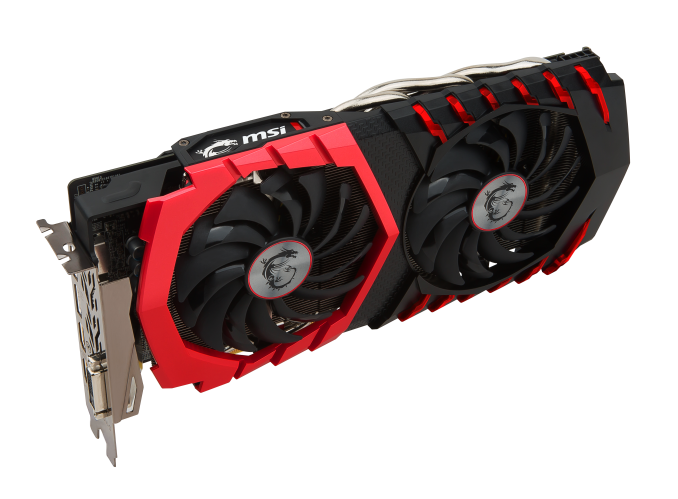MSI Shows New Radeon RX 480 Gaming Cards, with an 8-pin
by Daniel Williams on July 26, 2016 10:30 AM EST
Today MSI is announcing the latest entry in the Gaming X GPU line with the Radeon RX 480 Gaming X 8G/4G cards as well as non-X variants. The main difference between the non-X and X cards is in the core and memory frequencies, with the X card having the higher performance. In return, there will be a small price difference between the two variants.
| MSI Radeon RX 480 Gaming Specification Comparison | |||||||
| GAMING X 8G | GAMING X 4G | GAMING 8G | GAMING 4G | ||||
| Core Clock |
Silent | 1266 MHz | |||||
| Gaming | 1303 MHz | 1279 MHz | |||||
| OC Mode | 1316 MHz | 1292 MHz | |||||
| Memory Clock (Reg/OC) | 8.0/8.1 Gbps GDDR5 | 8.0 Gbps GDDR5 | |||||
| VRAM | 8 GB | 4 GB | 8 GB | 4 GB | |||
| Launch Date | TBD Mid August 2016 | ||||||
| Launch Price | Unknown ??? | ||||||
Starting with appearance, all four models shown today feature an angular, aggressive, red and black design for the cooler, which glows through the red highlights. On the side of the card is an MSI logo lit by customizable RGB lighting which is adjusted through the MSI Gaming software bundled with the card. Around back there is a full cover back plate on the Gaming X cards, and moving back around to the cooler we have two large fans over a full-length cooler and PCB. Running through the heatsink are three heat pipes at 8mm thick each. These heat pipes are squared off at the bottom and mated to a nickel-plated copper baseplate, aiming to increase contact with the GPU core and hence increase heat transfer. This cooler is toned down from that used on the highest end cards, but should still make for a very capable cooling solution.
Moving from form over to function, MSI’s RX 480 Gaming X cards are built from what MSI calls “Military Class 4” components, which is marketing speak for their choosing quality components to assemble this card. For power, the cards have a single 8-pin connector, and for the output we have two HDMI, two DisplayPort, and one DVI-D connection. This appears to be a very popular arrangement this generation, allowing one HDMI port for a monitor and another for a VR headset. MSI also use their TORX Fan 2.0 design which they say will generate 22% more air pressure, and like other Gaming and Gaming X cards the fans will shut off at temperatures below 60C. If true these fans coupled with the Twin Frozr VI heatsink could do an admirable job of quietly handling any heat an RX 480 can muster. For performance numbers on the Gaming X, we have a moderate clock speed gain over the reference card in OC mode, while the memory is bumped up to 8.1 Gbps in OC mode.
With no word on pricing, both 8GB and 4GB versions of the MSI Radeon RX 480 Gaming X are expected to be in stores worldwide around the middle of August 2016.



















34 Comments
View All Comments
JoeyJoJo123 - Tuesday, July 26, 2016 - link
I feel like blower style cards would benefit a lot more from having a 3-slot cooler. There's a lot of back pressure with trying to blow air out when 1-slot of the 2-slots at the exhaust exit is covered with ports, leading to reduced performance.3-slots would give blower style cards a thicker fan, for more air volume being pushed, a larger volume of heatfins where heat can accumulate before it's transfered into the air, and 2-slots worth of exhaust space, rather than the usual 1-slot (or less when they also decide to shove a DVI-D port there, too).
Blower style cards get a lot of flak, but nobody really makes them right. No, not even the Nvidia reference blowers are great due to the 2-slot width, and therefore compromised performance.
Although, having a 3-slot width basically makes them incompatible with most miniITX cases which would really want to have a good blower style cooler, I still think someone should be making a legitimately no-compromise blower style cooler sometime. We've had 2.5-slot and 3-slot width open-air GPU coolers before, but never 3-slot width blower-style GPU coolers.
Mr Perfect - Wednesday, July 27, 2016 - link
The 10 series blowers are a little bit better then in the past. The HDMI and DP outputs are so short that they only take up about half a slot in height. You can see it in the 1080n review here.http://api.viglink.com/api/click?format=go&jso...
It's just that miserable DVI port that's blocking so much airflow. You can't see any fins at all on the right side of that picture.
sonicmerlin - Tuesday, July 26, 2016 - link
This card will be pulling 220W minimum.angrysand - Monday, August 1, 2016 - link
so the 6- vs 8-pin difference being that the 6-pin can provided 75W of power whereas the 8-pin can provide up to 150w. The article doesn't explain this, but would this be a correct presumption?